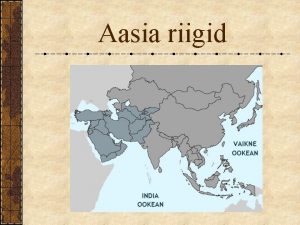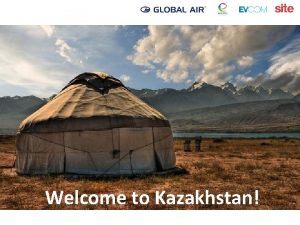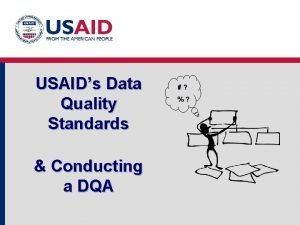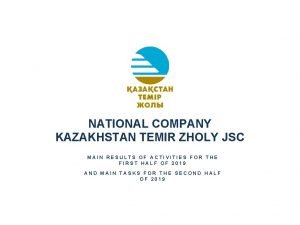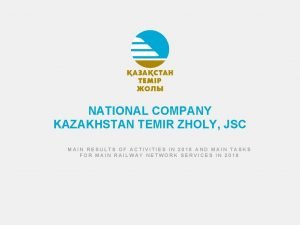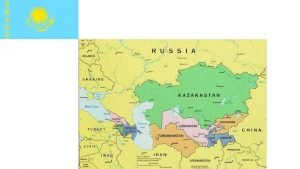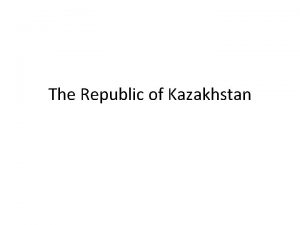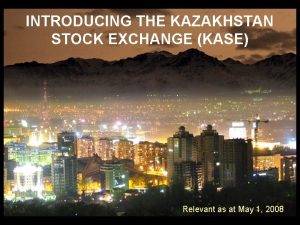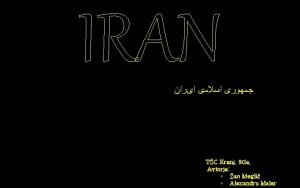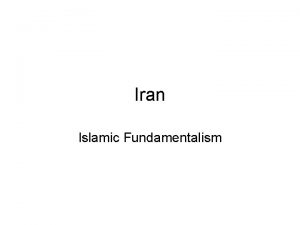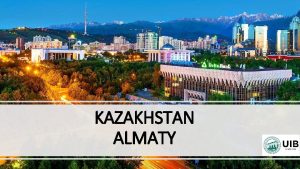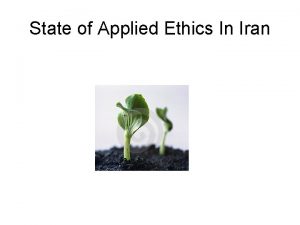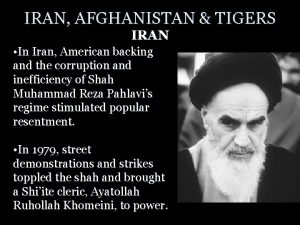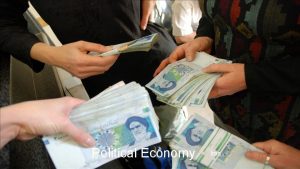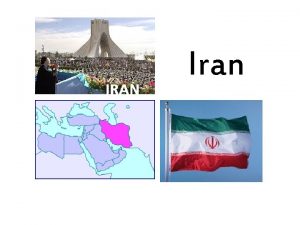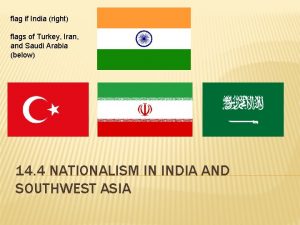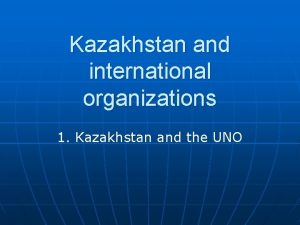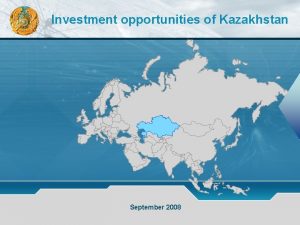India Gas Supply Options KAZAKHSTAN TURKEY AFGANISTAN IRAN

























- Slides: 25

India Gas Supply Options KAZAKHSTAN TURKEY AFGANISTAN IRAN PAKISTAN INDIA Franz B. Ehrhardt, President & MD, Conoco Eurasia, Istanbul Copyright© 2005 CASCA Consulting, L. L. C. All rights reserved

Gas Supply Demand Balance § Domestic production in 1996: 23 Bcm § Natural Gas Production (97): 0. 7 trillion (Tcf) § Natural Gas Consumption (97): 0. 7 Tcf § Natural Gas Reserves (98): 17. 4 trillion cubic feet (Tcf) 12/24/2021 § Supply for 2001: 28 Bcm § Natural gas from the following sub sea pipes are expected: Oman pipeline: 20 BCM/yr Iran: 20 BCM/yr § With these 63/73 BCM of gas is expected to be available in 2001 2002. Copyright© 2005 CASCA Consulting, L. L. C. All rights reserved 2

Gas Supply – Demand Balances Natural Gas Supply Options to India 4000 3500 3000 1500 Iran 1000 NG Production ( BCF) 500 2500 BCF 2000 Oman 0 3000 Turkmenistan 2500 2000 1500 1000 500 1997 2000 2002 2005 2010 Year 12/24/2021 NG Consumption (BCF) 0 1997 Copyright© 2005 CASCA Consulting, L. L. C. All rights reserved 2000 2002 2005 2010 Years 3

Gas Supply Demand Balance (cont´d) Natural Gas Supply & Demand in India 2000 BCF 1500 1000 Consumption 500 Production 0 1987 1988 1989 1990 1991 1992 1993 1994 1995 1996 2000 Years Copyright© 2005 CASCA Consulting, L. L. C. All rights reserved

Gas Supply Demand Balance (cont´d) Total supply of NG in 2001 2002 20 BCM 28 BCM Domestic Production Import of nag from Iran Import of nag from Oman 20 BCM Copyright© 2005 CASCA Consulting, L. L. C. All rights reserved

Gas Supply Demand Balance (cont´d) BCM Demand of NG (BCM) 80 70 60 50 40 30 20 10 0 75 55 30 1996 2001 2002 2005 Years Demand (BCM) Copyright© 2005 CASCA Consulting, L. L. C. All rights reserved

Gas Supply Demand Balance (cont´d) 80 Demand Supply Balance in 2001 2002 BCM 60 40 68 55 20 28 20 20 0 Demand Domestic Import of nag Total Supply Production from Iran from Oman Of nag OPTIONS Copyright© 2005 CASCA Consulting, L. L. C. All rights reserved

Gas Supply Demand Balance (cont´d) 80 Demand Supply Balance in 2001 2002 BCM 60 40 68 55 48 20 0 28 Demand Domestic pro without Iran &Oman with Iran OPTIONS Copyright© 2005 CASCA Consulting, L. L. C. All rights reserved with Iran & Oman

Gas Supply Demand Balance (cont´d) Demand & Supply Position in 2010 Shortfall 27% Production 31% Import 42% Copyright© 2005 CASCA Consulting, L. L. C. All rights reserved

Natural Gas & Energy Overview • Natural gas supplies about 7% of India's energy demand. – Most of the increased demand is expected to be met through imports. Increased use of natural gas in power generation is expected to account for a large share of the demand increase. • India is investing in infrastructure that will be needed to meet the increase in natural gas requirements by expanding domestic pipeline capacity and building facilities to handle imports of liquefied natural gas (LNG). Copyright© 2005 CASCA Consulting, L. L. C. All rights reserved

Natural Gas & Energy Overview • RESERVES: Almost 70% of India's natural gas reserves are found in Bombay High basin and the Gujarat region. – Current projects include enhancing gas production at the Tapti fields, recovering flared gas at Bombay High, and expanding pipeline capacity from the Bombay North field (from about 635 million cubic feet/day, mmcf/d, to nearly 1200 mmcf/d). – Gas Authority of India Limited (GAIL) is also expanding its HBJ pipeline between Hazira and the outskirts of Delhi. The added pipeline capacity will serve new power, petrochemical, and fertilizer plants in Gujarat, Madhya, and Uttar provinces. • PROJECTS: India Gas Corp. plans a $2. 5 billion joint venture pipeline (with Brown & Root and Cairn Energy) from offshore Myanmar to southern India (nearly 1 Bcf/day capacity). – Other longer term projects would transport natural gas from Oman, Iran, and Turkmenistan. • As an alternative to natural gas, India is pursuing future development of its coal bed methane reserves, estimated to total about 35 Tcf. Copyright© 2005 CASCA Consulting, L. L. C. All rights reserved

LNG Supply to India • The emerging delays in gas pipeline projects have made it necessary to expedite LNG project and consider larger imports of LNG to augment long term gas supplies. – Other than diversifying the gas supplies to enhance security of supply, speedy approval and implementation of the LNG project would help meet the growing gas demand in South India. • Middle East countries and South East Asian countries like Indonesia and Malaysia can supply LNG to India. • Petronet has short listed 7 companies to bid on supplying 7. 5 million metric tons per year (mmt/y) of LNG beginning in 2002: Shell, Petronas, Total, Pertamina, Chevron, Ras Laffan Mobil, and Woodside Petroleum. – Sales and purchase agreements are expected to be concluded by early 1999. – Petronet plans LNG receiving terminals at Dahaj (5. 0 mmt/y) and Cochin (2. 5 mmt/year) and another on the east coast; longer term plans include terminals at Mangalore and Ennore (5. 0 mmt/y each). Copyright© 2005 CASCA Consulting, L. L. C. All rights reserved

LNG Supply to India (cont´d) • International consortiums including Enron, Shell, British Gas and Elf have bid for the construction of LNG terminals in India. – Implementation: Min. 5 years – Investment required: US$ 10 billion. • Enron is involved in negotiations on a $4 billion project to import 5 mmt/y of LNG from Qatar by 2001 (including 2 mmt/y for its Dabhol power plant). Reliance Industries is planning two 5 mmt/y terminals at Hazira and Janmagar in Gujarat. • Qatar and India sign an MOU for supplying India with LNG – Qatar´s Rasgas (Mobil has 25% share) hopes to sign LNG (SPA) agreement with India. – Rasgas won a tender to supply 7. 5 million tonnes/yr to India's Petronet. – Delivery in 2002 Copyright© 2005 CASCA Consulting, L. L. C. All rights reserved

LNG Supply to India (cont´d) • TOTAL and Hindustan Petroleum Corporation Ltd. have an agreement to develop LNG projects. – TOTAL has 4 LNG projects in Abu Dhabi, Qatar, Oman and Yemen and liquefaction complex project in Indonesia. • Nigeria is expected to supply after 2000. • British Gas is developing a project to import LNG from Yemen for a power plant at Pipavav port on the west coast (2. 65 mmt/y initially) • Shell to supply India with Oman LNG – by 2001 – 2. 5 million tonnes from Oman fields of Shell – Shell plans to build a 1400 MW power plant in South India. – Shell would be able to supply more gas to India from other discovered fields in Australia, Russia, Malaysia, Brunei and Nigeria by 2004 2005. • In addition to Petronet, other companies have proposed projects to construct LNG import facilities, to provide fuel for power generation. If all of the projects were built, the country would have the capacity to import 50 mmt/y of LNG. Copyright© 2005 CASCA Consulting, L. L. C. All rights reserved

Turkmenistan Pakistan Gas Pipeline (cont’d) • MOU btw. Turkmenistan and Pakistan in 1993 to build a gas pipeline from Turkmenistan to Pakistan via Afghanistan was signed. • Bridas (Argentina), Gazprom and Indian government were interested in this project. – Capacity: 20 BCM – Reserves in Turkmenistan: 800 BCM – Diameter: 510 mm – Length: 1400 km – Construction cost: US$ 3. 5 billion – Problem: Difficulties btw. Bridas and Ashgabat • Possibility of extending this line to northern India markets. Copyright© 2005 CASCA Consulting, L. L. C. All rights reserved

Turkmenistan Pakistan Gas Pipeline (cont’d) • In 1995 Turkmen government signed an agreement with a consortium of Unocal and Delta Oil Company (Saudi Arabia) to build a 1300 km (48 inch) pipeline from Turkmenistan to Pakistan via Afghanistan. – Capacity: Similar to planned Bridas line (700 billion cubic feet of gas) – Construction costs: US$ 1. 9 billion – Extension to northern India: additional US$ 600 million – Unocal Delta aimed to build and operate gas fired power plants in Pakistan. • In 1997 Central Asia Gas Pipeline Consortium was set by Turkmen government. (Unocal: 46. 5%, Delta: 15%, Turkmen Govt. : 7%, Indonesia Petroleum (Japan): 6. 5%, Itochu (Japan): 6. 5%, Hyundai (South Korea): 5%, Crescent Group (Pakistan): 3. 5% with 10% for Gazprom. ) • Adding a nearly 400 mile spur to the Indian capital of New Delhi, require cooperation between Pakistan and India. Copyright© 2005 CASCA Consulting, L. L. C. All rights reserved

Turkmenistan Pakistan Gas Pipeline (cont’d) Problems associated with this project: • Afghanistan ( pipe would cross through 725 km of Taliban territory): – security threat – lack of internationally recognised government which is required for financing issues. – Wait till the conditions are stabilised in Afghanistan. – Civil war in Afghanistan – war torn Afghanistan continues to experience fighting, and in the absence of a stable political situation, it may be years before the pipeline project is feasible Taliban militants seem to agree to this project. • Political difficulties btw India and Pakistan • Pakistan demand for NG may not be enough to justify a gas pipeline. (extension to India necessary. ) there are questions regarding the need for large scale gas imports to Pakistan, particularly given recent significant domestic gas discoveries. • Bridas has threatened to take legal action against Unocal and Delta for allegedly conspiring to undermine its efforts to build a Turkmenistan Afghanistan Pakistan gas pipeline from its Yashlar field. Copyright© 2005 CASCA Consulting, L. L. C. All rights reserved

Pakistan ENERGY • Pakistan consumed 1. 68 quadrillion Btu (quads) of primary energy and produced 1. 11 quads in 1996. This compares to 93. 4 quads of consumption and 72. 6 quads of production in the United States in 1996. – Pakistan's energy supply mix in 1996 1997 was estimated at 27% oil, 24% natural gas, 20% wood, 16% other biomass, 9% hydroelectric/nuclear, and 4% coal. – In recent years, Pakistan has faced chronic energy shortages as demand growth has outpaced supply. – Energy in Pakistan is consumed by the industrial sector (39%), transportation (32%), households (23%), agriculture (3%), and commercial sector (3%). In coming years, Pakistan hopes to convert more of its energy consumption to domestic natural gas and away from imported oil. – Overall, energy supply is a critical issue for Pakistan as its population, economy, and energy demand grow rapidly. – Insufficient energy supplies could act as a constraint on economic growth. Copyright© 2005 CASCA Consulting, L. L. C. All rights reserved

Pakistan (cont´d) • With gas demand also growing rapidly (possibly more than 30% by 2003), domestic supplies of natural gas may require supplemental imports most likely from the Middle East and/or Central Asia. • In 1998, Hardy Oil and Gas and Austria's OMV announced a major natural gas find at its South West Sindh Province. – According to reports, the find could represent the largest gas discovery in Pakistan and could add 25% to the country's reserves. – This could have a significant impact on Pakistan's future gas import plans, including the Unocal consortium pipeline and the pipeline from Iran's South Pars field. – Production from South West Miano is scheduled to begin in 2002. – In another development, Lasmo announced that a gas discovery it had made north of Karachi could yield 1 3 Tcf of gas. Copyright© 2005 CASCA Consulting, L. L. C. All rights reserved

Iran India Pipeline § Iran has large gas reserves. § 27 BCM of gas will be supplied § 4 years for Iran to supply the gas § Problems associated with this route: § High cost & political obstacles § Onshore or Offshore (seabed) alternatives Copyright© 2005 CASCA Consulting, L. L. C. All rights reserved

Iran India Pipeline (cont’d) ONSHORE: • 1600 km • overall cost: US$ 5 billion (continuation to India cost US$ 1. 5 billion. ) • Problems associated with this project: – Financial requirements are high • non national financial backing • multilateral lending agency – Pakistan territory as a threat to constant gas flow – Difficult to complete in the short time Copyright© 2005 CASCA Consulting, L. L. C. All rights reserved

Iran India Pipeline (cont’d) OFFSHORE: VIA PAKISTAN • Problems associated with this project: – Pakistan may refuse to grant access to its territory. (maritime & land) – Pakistan says it will not allow any offshore line passing through its waters. – Political considerations – Lobby against an offshore project Copyright© 2005 CASCA Consulting, L. L. C. All rights reserved

Oman India Pipeline • In 1994, Oman signed an agreement with India to build a 600 mile underwater pipeline to carry Oman gas to Indian western coast. • 28 inch pipeline from Oman to India • 20 BCM capacity • 3500 m water depth • US$ 5 10 billion • 1 Bcf/day by 1999 (Subsequently, a second 1 Bcf pipeline would be built by 2001) • NG exports of around US$ 50 billion over the project's lifetime. Copyright© 2005 CASCA Consulting, L. L. C. All rights reserved

Oman India Pipeline (cont’d) • Problems associated with this project: – Insufficient reserves – Technical problems (laying a pipeline at a depth of 3. 5 km) depth of the pipeline, which would be over four times deeper than the world's present deepest underwater pipeline – Financial problems (cost rising over to US$ 7 billion) – By January 1997, Omani officials announced that Oman was abandoning the project. • The officials cited doubts over the project's technical feasibility and whether the Gas Authority of India and OOC set up a joint working group to provide additional information on technical feasibility, gas reserves and financing. • The additional studies could take up to two years and new bids for the pipeline's construction may be required. Copyright© 2005 CASCA Consulting, L. L. C. All rights reserved

Oman Gas Reserves • As part of its economic diversification strategy, the government is attempting to transform Oman into a major natural gas exporter. – Through an extensive exploration program, Oman has consistently increased its natural gas reserves in recent years. – In 1996, Oman had proven reserves of 25 trillion cubic feet (Tcf). For 1997, proven reserves jumped 20% to 30 Tcf. – About one third of this amount is associated gas, most of which is located in the Natih and surrounding fields. – Over 10 Tcf of Oman's non associated gas is located in deep geological structures, many of which are beneath active oil fields. • About two thirds of Oman's gas production is associated gas, and one third non associated. – PDO produces the majority of Oman's associated gas, as well as non associated gas from Yibal and Lekhwair. Natural Gas Reserves (1/1/97): 30. 0 trillion cubic feet Natural Gas Production (1996 E): 149 billion cubic feet (Bcf) Natural Gas Consumption (1996 E): 131 Bcf Copyright© 2005 CASCA Consulting, L. L. C. All rights reserved
 Mevlana 30
Mevlana 30 Afganistan pealinn
Afganistan pealinn Afganistan
Afganistan Lola bellici
Lola bellici Guerra de afganistan
Guerra de afganistan Afganistan nerastne bohatstvo
Afganistan nerastne bohatstvo Ndc kazakhstan
Ndc kazakhstan Local guide program
Local guide program Sherkala and kok-tobe are
Sherkala and kok-tobe are Inflation rate kazakhstan
Inflation rate kazakhstan Education system in kazakhstan presentation
Education system in kazakhstan presentation Kazakhstan government type
Kazakhstan government type Usaid data quality standards
Usaid data quality standards Primary school in kazakhstan
Primary school in kazakhstan Peter stegnar
Peter stegnar Kazakhstan temir zholy
Kazakhstan temir zholy Kazakhstan temir zholy
Kazakhstan temir zholy Lesson structure
Lesson structure Aiesec kazakhstan
Aiesec kazakhstan Caspian marine services kazakhstan
Caspian marine services kazakhstan Kase kazakhstan
Kase kazakhstan Turkuaz machinery kazakhstan
Turkuaz machinery kazakhstan Satrapy of iran
Satrapy of iran Iran hostage crisis timeline
Iran hostage crisis timeline Iran prebivalstvo
Iran prebivalstvo Persian cat map
Persian cat map

